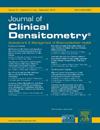评估DXA扫描仪漂移对骨密度变化误分类的影响:马尼托巴骨密度登记
IF 1.6
4区 医学
Q4 ENDOCRINOLOGY & METABOLISM
引用次数: 0
摘要
采用双能x线骨密度仪(DXA)测量骨密度(BMD)被广泛用于评估骨质疏松症和监测未治疗和治疗个体的骨密度。DXA扫描仪可能出现系统性的误差来源,包括校准漂移。出版物建议漂移容忍度在0.5 %至1.5 %之间,但没有证据依据。本研究旨在直接确定不同程度的模拟DXA校准漂移如何影响常规临床实践中BMD变化的错误分类。使用来自马尼托巴骨密度计划的数据,我们访问了14942名年龄在40岁及以上的个体的结果,这些个体在1-5年的间隔内进行了基线和重复的全髋扇形束DXA测量。少量的模拟漂移(绝对0.003 g/cm2或相对0.25 %)影响不大,导致小于5 %的BMD变化误分类。当绝对骨密度漂移大于0.006 g/cm2或相对漂移大于0.75 %时,误分类率超过10 %;当绝对骨密度漂移大于0.024 g/cm2时,误分类率大于35 %。当根据抗骨质疏松药物的使用、改变最不显著变化(LSC)和评估腰椎骨密度变化对结果进行分层时,也可以看到类似的趋势。综上所述,相对较小程度的DXA校准漂移可能对BMD变化的错误分类产生很大影响。我们的结果支持0.006 g/cm2或0.5 %的校准漂移公差。这些发现可能有助于指导DXA扫描仪维修和修复的时机。本文章由计算机程序翻译,如有差异,请以英文原文为准。
Assessing the effect of DXA scanner drift on misclassification of bone density change: The Manitoba BMD registry
Bone mineral density (BMD) measurement with dual-energy X-ray absorptiometry (DXA) is widely used to assess osteoporosis and monitor BMD in untreated and treated individuals. Systematic sources of error can occur with DXA scanners, including calibration drift. Publications suggest a drift tolerance in the range 0.5 % to 1.5 %, but are not evidence- based. The current study was performed to directly determine how varying degrees of simulated DXA calibration drift would affect misclassification of BMD change in routine clinical practice. Using data from the Manitoba Bone Density Program, we accessed results for 14,942 individuals age 40 years and older undergoing baseline and repeat fan-beam DXA measurements of the total hip within an interval of 1-5 years. A small amount of simulated drift (absolute 0.003 g/cm2 or relative 0.25 %) had little effect, and resulted in less than 5 % BMD change misclassification. Misclassification exceeded 10 % with absolute BMD drift greater than 0.006 g/cm2 or relative drift over 0.75 %, and was greater than 35 % for absolute BMD drift of 0.024 g/cm2. Similar trends were seen when results were stratified according to use of anti-osteoporosis medication, when varying the least significant change (LSC), and for evaluating lumbar spine BMD change. In summary, relatively small degrees of DXA calibration drift can have large effects on misclassifying BMD change. Our results support a calibration drift tolerance of 0.006 g/cm2 or 0.5 %. These findings may help to guide timing for DXA scanner servicing and repair.
求助全文
通过发布文献求助,成功后即可免费获取论文全文。
去求助
来源期刊

Journal of Clinical Densitometry
医学-内分泌学与代谢
CiteScore
4.90
自引率
8.00%
发文量
92
审稿时长
90 days
期刊介绍:
The Journal is committed to serving ISCD''s mission - the education of heterogenous physician specialties and technologists who are involved in the clinical assessment of skeletal health. The focus of JCD is bone mass measurement, including epidemiology of bone mass, how drugs and diseases alter bone mass, new techniques and quality assurance in bone mass imaging technologies, and bone mass health/economics.
Combining high quality research and review articles with sound, practice-oriented advice, JCD meets the diverse diagnostic and management needs of radiologists, endocrinologists, nephrologists, rheumatologists, gynecologists, family physicians, internists, and technologists whose patients require diagnostic clinical densitometry for therapeutic management.
 求助内容:
求助内容: 应助结果提醒方式:
应助结果提醒方式:


